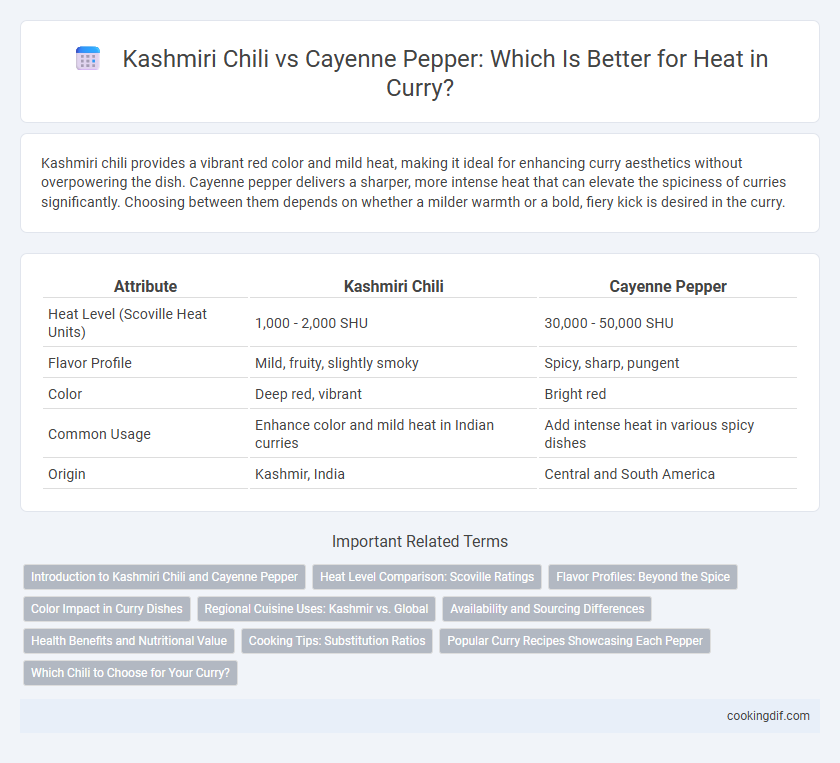Kashmiri chili provides a vibrant red color and mild heat, making it ideal for enhancing curry aesthetics without overpowering the dish. Cayenne pepper delivers a sharper, more intense heat that can elevate the spiciness of curries significantly. Choosing between them depends on whether a milder warmth or a bold, fiery kick is desired in the curry.
Table of Comparison
| Attribute | Kashmiri Chili | Cayenne Pepper |
|---|---|---|
| Heat Level (Scoville Heat Units) | 1,000 - 2,000 SHU | 30,000 - 50,000 SHU |
| Flavor Profile | Mild, fruity, slightly smoky | Spicy, sharp, pungent |
| Color | Deep red, vibrant | Bright red |
| Common Usage | Enhance color and mild heat in Indian curries | Add intense heat in various spicy dishes |
| Origin | Kashmir, India | Central and South America |
Introduction to Kashmiri Chili and Cayenne Pepper
Kashmiri chili, known for its vibrant red color and mild heat level ranging from 1,000 to 2,000 Scoville Heat Units (SHU), imparts a rich, smoky flavor ideal for enhancing curries without overwhelming spice. Cayenne pepper, significantly hotter with a heat level between 30,000 to 50,000 SHU, delivers a sharp, intense heat often used to add fiery spice to dishes. Both spices contribute distinct heat profiles and flavor nuances, making them crucial for tailoring the spiciness and color in Indian and global cuisine.
Heat Level Comparison: Scoville Ratings
Kashmiri chili typically rates between 1,000 to 2,000 Scoville Heat Units (SHU), offering a mild to moderate heat with vibrant color, whereas Cayenne pepper ranges from 30,000 to 50,000 SHU, delivering significantly more intense heat. This substantial difference in Scoville ratings makes Cayenne pepper ideal for those seeking pronounced spiciness, while Kashmiri chili provides mild warmth with a rich red hue. Understanding these heat level distinctions helps in selecting the appropriate chili to balance flavor and heat in curry recipes.
Flavor Profiles: Beyond the Spice
Kashmiri chili offers a vibrant red hue with a mild to moderate heat level, delivering earthy and fruity undertones that enhance the complexity of curries without overwhelming the palate. Cayenne pepper provides a sharper, more intense heat accompanied by a slightly smoky and pungent flavor, often used to elevate the spiciness with aggressive warmth. Both spices contribute distinct flavor profiles: Kashmiri chili enriches color and subtle aroma, while cayenne intensifies heat and adds a bold punch to curry dishes.
Color Impact in Curry Dishes
Kashmiri chili imparts a vibrant red hue to curry dishes, enhancing visual appeal without overwhelming heat, typically ranging 1,000-2,000 Scoville Heat Units (SHU). Cayenne pepper delivers a sharper, more intense heat at 30,000-50,000 SHU, often resulting in a deeper, orange-red color that can overshadow subtle dish tones. Choosing Kashmiri chili is ideal for balanced heat with bright color impact, while cayenne suits those prioritizing spiciness and a darker red appearance.
Regional Cuisine Uses: Kashmir vs. Global
Kashmiri chili delivers a moderate heat with vibrant red color, essential in Kashmiri cuisine for enhancing dishes like rogan josh and gushtaba with its mild spiciness and deep aroma. Cayenne pepper provides a sharper, more intense heat preferred globally in dishes requiring strong spice, commonly used in South American, Cajun, and Southeast Asian recipes. The regional usage highlights Kashmiri chili's role in subtle, aromatic heat contrasted by cayenne's widespread application for bold, fiery flavor profiles.
Availability and Sourcing Differences
Kashmiri chili is prized for its vibrant red color and mild heat, typically sourced from the Kashmir region in India where it thrives in specific climatic conditions, making it less readily available in global markets compared to cayenne pepper. Cayenne pepper, widely cultivated in regions such as India, China, and the Americas, enjoys broad commercial availability due to its adaptability and mass production. The sourcing differences also reflect in price and freshness, with Kashmiri chili often commanding a premium in specialty spice stores, while cayenne pepper is a staple in most supermarkets worldwide.
Health Benefits and Nutritional Value
Kashmiri chili offers moderate heat with a vibrant red color, rich in antioxidants such as vitamin A and capsaicin, which support metabolism and immune health. Cayenne pepper delivers a higher level of heat, containing significant amounts of capsaicin that promote pain relief, improve digestion, and boost circulation. Both spices provide essential nutrients, but cayenne's intense capsaicin concentration offers stronger anti-inflammatory and cardiovascular health benefits.
Cooking Tips: Substitution Ratios
Kashmiri chili provides moderate heat with a vibrant red color, ideal for authentic Indian curries, while cayenne pepper offers a much higher heat level with a sharper, more intense spice. When substituting, use 1 teaspoon of Kashmiri chili in place of 1/4 teaspoon of cayenne pepper to maintain balanced heat without overpowering the dish. Adjust ratios carefully to preserve the desired flavor profile and color in your curry recipes.
Popular Curry Recipes Showcasing Each Pepper
Kashmiri chili offers a mild heat and vibrant red color, making it ideal for dishes like Rogan Josh and Dum Aloo, where its subtle warmth enhances flavors without overpowering the palate. Cayenne pepper delivers a sharper, more intense heat perfect for spicy curries such as Vindaloo and Chicken Tikka Masala, adding a fiery kick that elevates the dish's bold taste. These peppers shape the heat profile of popular curry recipes, balancing flavor depth and spiciness to suit different culinary preferences.
Which Chili to Choose for Your Curry?
Kashmiri chili offers a vibrant red color and mild heat, making it ideal for adding depth and color to curries without overpowering spice levels. Cayenne pepper delivers a much sharper, intense heat, preferred for those seeking a fiery kick in their dishes. Choosing between Kashmiri chili and Cayenne pepper depends on desired heat intensity and flavor complexity in your curry recipes.
Kashmiri chili vs Cayenne pepper for heat Infographic

 cookingdif.com
cookingdif.com